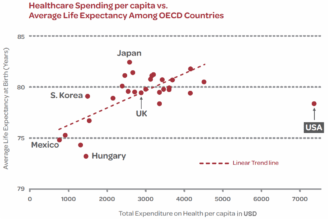The following appeared yesterday in The Fiscal Times:
The White House later this month is likely to approve a highly controversial clean air regulation that will force the electricity industry to either clean up or replace its oldest and dirtiest coal-fired generation plants.
The following appeared yesterday in The Fiscal Times:
The White House later this month is likely to approve a highly controversial clean air regulation that will force the electricity industry to either clean up or replace its oldest and dirtiest coal-fired generation plants.
Though the country is mired in slow-growth and a near jobless economic recovery, the Obama administration’s Environmental Protection Agency plans to order the clean-up for one compelling and hard-to-ignore reason: the health benefits for the American public far exceed the costs to either the industry or electricity consumers. The coal plant “maximum achievable control technology” or MACT rule would provide an estimated $10 in health benefits for every $1 of industry costs, according to the EPA.
Republicans are already lining up to blast the decision as a “job killing” federal regulation.
Unlike a proposed ozone abatement rule that the White House postponed earlier this year that targeted a broad swath of industries for much smaller health benefits, the MACT rule only applies to dirty coal-fired plants. The government is under court order to come up with the rule by December 16 after a coalition of environmental groups won a suit against President George W. Bush’s administration, which had stonewalled implementation for eight years.
Most of the benefits, estimated at $100 billion a year, will come in the form of a sharp reduction in the 13,000 to 17,000 premature deaths that occur annually when elderly Americans are exposed to particulate matter belched from uncontrolled coal plant smokestacks. An estimated 74 gigawatts of capacity or 23 percent of the nation’s coal-fired electricity comes from plants over 40 years old that are not equipped with modern pollution scrubbers. Virtually all of those plants are located east of the Mississippi River.
“The studies provide compelling evidence that short-term exposure to heightened levels of air pollution over a few days increases the risk of both respiratory and cardiovascular events, including death,” said Brigham Young University economics professor C. Arden Pope, who considered himself a skeptic when he began his research over a decade ago. “Reducing particulate pollution provides you with almost immediate benefits that are substantial.”
But that hasn’t stopped the coal-dependent sectors of the electricity industry and coal producers from waging a fierce struggle in Congress and the courts for more than two decades to stop implementation of the rule under the Clean Air Act and its 1990 amendments. The 1990 amendments mandated that industry adopt the best available technology for scrubbing smokestack emissions without regard to cost because of the demonstrated health benefits, which in those days were far less certain.
Now, having lost in court and with the health effects better documented, the industries directly hit by the rule have taken to airwaves and deployed an army of lobbyists to push their cause at the White House, on Capitol Hill and in state capitals, where 24 state attorneys general have voiced opposition.
The American Coalition for Clean Coal Electricity, whose membership roster includes American Electric Power, Southern Company, Peabody Coal, Caterpillar, and GE Energy, claims in its ads that the MACT rule will “destroy over 180,000 jobs per year,” force consumers to pay over $120 billion in higher electricity costs and $50 billion in higher natural gas prices over the next decade.
“The average U.S. family loses $270 per year in disposable income,” an analysis by a consulting firm hired by the industry claimed. That translates into about a 6 percent to 7 percent increase in utility costs over the next decade.
It’s an expense households should gladly embrace, environmentalists and health advocates say, since the health benefits will reduce other household expenses and penalties by a far greater amount. In addition to premature deaths, power plant pollution triggers an estimated 20,000 heart attacks a year and hundreds of thousands of asthma attacks, which translates into higher health care costs and higher health insurance premiums for the general public.
The clean-up would also sharply reduce mercury and other toxic chemical emission. Those dangerous emissions are associated with as many as 2,675 excess cases a year of mental retardation, according to the EPA, which costs the health care and education systems as much as $3.3 billion a year. The Sierra Club and other environmental groups have focused their public relations strategy on that particular cost, running billboard ads throughout the nation’s capital showing a pregnant woman wondering how much mercury is in her developing fetus.
Environmentalists also question the claims about lost jobs, since plants that install scrubbers will create thousands of jobs for engineers and construction workers employed to build the facilities. And while some ancient coal-fired plants will undoubtedly be closed, they will in all likelihood be replaced by cleaner natural gas-fired, coal-fired or renewable electricity generation facilities. Manpower to build and operate those new plants will replace many if not most of the jobs lost at older plants and in the nation’s coal mines, which today employ fewer people than the solar energy industry.
“There will be a tremendous number of high wage jobs created by the rule,” said John Walke, an attorney for the Natural Resources Defense Council. He was part of the legal team that brought the suit against the Bush administration that led to the current rule.
Republicans in the House, hoping to turn the Obama administration’s likely backing of the rule into an election year issue, have mounted a last-minute attack on the EPA’s science, which is getting its final review by the Office of Management and Budget. Cass Sunstein, who heads the administration’s Office of Information and Regulatory Affairs, is a long-time acquaintance of the president.
Reps. Andy Harris, R-Md., and Paul Broun, R-Ga., who are both physicians and both serve on the House Committee on Science, Space and Technology, charged in a letter to Sunstein in mid-November that his agency was engaged in “troubling scientific and economic accounting practices” that “appear designed to provide political cover for a more stringent regulatory agenda rather than to objectively inform policy decisions.”
Harris and Broun questioned the EPA’s failure to subtract the health care costs of people who lost their jobs in the calculation. They also cited a paper Sunstein wrote while at the University of Chicago, which said “it makes a great deal of sense to focus on statistical life-years rather than statistical lives.”
“In spite of the fact that most mortality associated with (particulate matter) happens in the population over 65 years of age, EPA puts the same value on mortality for all ages,” the two physician-legislators wrote. “In your view, is this practice appropriate?”
The Bush administration’s budget office attempted to substitute a lower value for senior citizens’ lives in regulatory cost-benefit analyses. But that move was abandoned quickly after it triggered a national uproar led by AARP and other senior groups. The House, which was controlled by Republicans at that time, unanimously passed a resolution condemning the move.
“It’s morally offensive to have that be suggested as a reason to weaken a rule that will save lives,” Walke of NRDC said. Like most environmental groups, NRDC has been stepping up its pressure in recent weeks to ensure the White House follows through on its commitment to finally force the electricity industry to install scrubbers or scrap aging coal-fired plants. And environmentalists believe they are nearing success.
“They [White House officials] viewed the ozone decision as a political liability” because of opposition from a wide swath of business groups like the National Association of Manufacturers and the U.S. Chamber of Commerce, Walke said. But with even some sections of the electric generation industry – companies that depend largely on natural gas and nuclear power – supporting the MACT rule, “they view this one as a political asset.”







